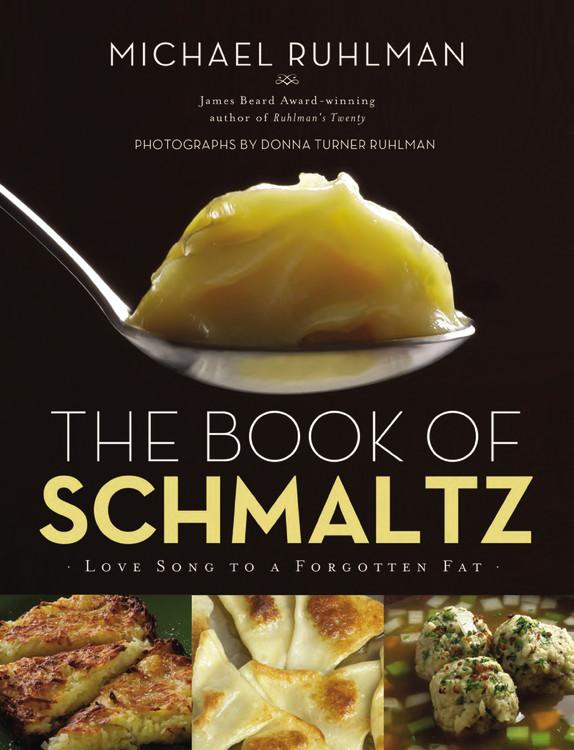 The Book Of Schmaltz:
The Book Of Schmaltz:
Love Song to a Forgotten Fat
Michael Ruhlman
Little, Brown & Company
2013, 192 pp. $25.00
Review by Gloria Levitas
Fat is Back
Think you know what to eat to stay healthy? That fats are bad for you? That you will never again be able to enjoy the umami taste of schmaltz on a piece of matzoh? Or the crunch of gribenes (chicken-skin cracklings) that brings back the joys of your grandmother’s kitchen? Well, let Michael Ruhlman’s Book of Schmaltz be your guide, and prepare for the return of the complex, savory richness that once flavored classic Jewish cuisine.
Ruhlman, a Cleveland-based chef who has received national attention for his nouveau-American cooking and his food writing, is not Jewish—he came to schmaltz through the proselytizing of his 78-year-old Jewish neighbor, Lois Baron. “There’s nothing else like it,” Baron lamented to him one night. “It’s a shame we’re losing it.” The comment prompted Ruhlman to delve into the many uses of this “neglected, much-maligned, all-but-forgotten fat”—forgotten largely because of a deep (and disproportionate) fear of fat in the United States.
But no more! The latest news from the nutrition police is that fat is actually good for you. Not all fats. Not too much fat. Not trans fats—and go easy on saturated fats. Olive oil is the obvious first choice. But just as you can’t create a symphony with one note, consider adding poultry fat and rejoice. Goose, duck and chicken fats—even turkey fat, used in one of Ruhlman’s recipes—are high in monounsaturated fats, which can lower bad cholesterol. They also contain more omega-3 fatty acids than most vegetable oils and are high in linoleic acid, which keeps cells healthy. As for trans fats, the amounts in poultry fats compare with many vegetable oils and are acceptable when used in reasonable quantities. So, as usual, grandmother was right when she urged you to use schmaltz on your Passover matzohs.
I had never seen or eaten gribenes until I was married and watched my mother-in-law make large piles of the crisp tasty bits, which disappeared rapidly as family members passed through her kitchen and grabbed them by the handfuls. My father was a chef of Sephardic origin, committed to olive oil and unfamiliar with the Eastern European kitchen. And my mother, who was Polish, made only a few classic dishes like stuffed cabbage and blintzes. Gribenes were a discovery. I made them occasionally, but as schmaltz became a taboo food, I gave them up. Until now.
Primarily enamored of schmaltz as an ingredient in the Jewish kitchen, and for its potential to enliven contemporary dishes, Ruhlman does not discuss the history and origin of this food in any detail. For the record, food historians agree that it was originally made by German Jews from rendered goose fat. Goose fat allowed them to make their own versions of many local dishes (like derma, also known as kishkas, or the dumpling-like kreplach or matzoh balls) while avoiding the use of lard (definitely not kosher) or butter, which would limit dishes (particularly desserts) to vegetarian meals. What the pig was to German Christians, the goose was to German Jews. Both offered delectable meat; the pig’s hide was used to make leather goods, while goose feathers were used for bedding; pig fat became lard, while goose fat, with the addition of onions, became schmaltz. Chicken fat replaced goose fat when geese were banished from American urban environments at the turn of the 20th century. By the l940s, chicken fat and butter were replaced by hardened and relatively tasteless vegetable fats such as Spry and Crisco, which could be baked into cakes and breads to accompany either meat or dairy dishes. Schmaltz (rendered with onions) virtually disappeared.
A while back, a friend forwarded me an anonymous email: Its ecstatic writer, intoxicated by memories of his family’s kitchen, where “schmaltz was the prime ingredient in almost every Jewish dish,” made “…plans to distribute it in a green glass Gucci bottle with a label clearly saying ‘Low fat, no cholesterol. Choice, extra virgin SCHMALTZ.’”
In place of the Gucci bottle, but glowing with the same spirit, is Ruhlman’s beautifully illustrated book, printed on glossy paper and crammed with gorgeous photographs taken by his wife, Donna Turner Ruhlman. At the heart of this book, subtitled Love Song to a Forgotten Fat, is his recipe for schmaltz. Ruhlman guides readers through this essentially simple recipe: Simmer the skin and fat from chicken thighs with onions and a bit of water, to yield both schmaltz and the gribenes.
Not content to revive and renew these classics, Ruhlman has gone on to incorporate schmaltz into contemporary dishes—chicken rillettes, savory brioche, vichysoisse, Parisian gnocchi and scones with red pepper and parmigiano reggiano, to name only a few. Of course, not all of these are kosher; some, like vichyssoise, must incorporate dairy. And if you think this savory fat is not suitable for baking sweets, just think about the new passion for salted caramels and chocolates; then try the oatmeal cookies with dried cherries. Personally, I can’t wait.
Gloria Levitas is an anthropologist and author who also has written on food and culture, psychology and literature, and has edited a collection of American Indian poetry.


I have to laugh schmaltz is my maiden name. We were told it mean fat or lard but also sentimental. Now a book on the subject. Wonder if this help with my family history research